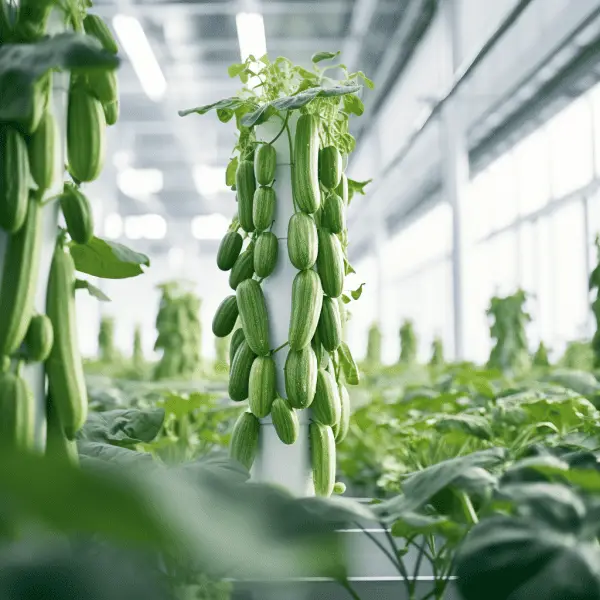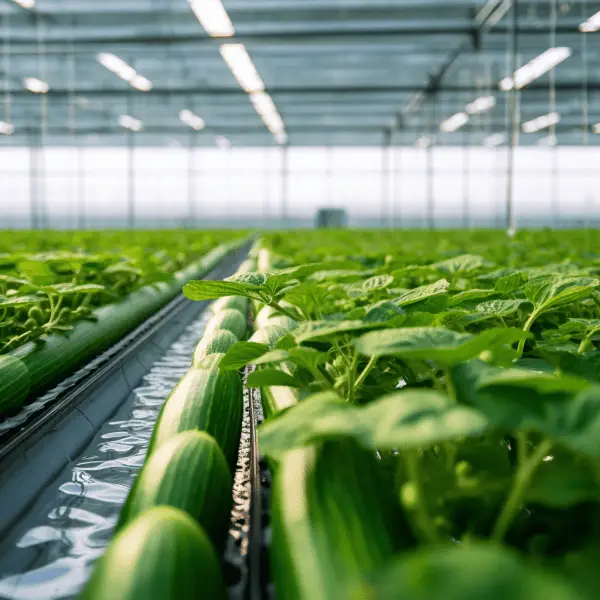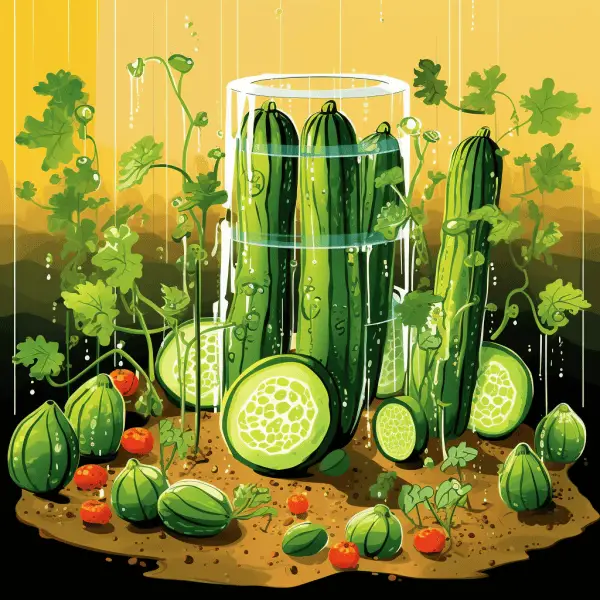If you love fresh cucumbers for salads, pickles, or just snacking, then let me let you in on a secret – growing them hydroponically is a game-changer! As an avid gardener with limited yard space, I’ve had great success nurturing these vine crops without soil using a simple DIY hydro system. The secret lies in providing nutrients via water and giving those fast-growing vines ample support. Before switching to hydroponics, my cucumber harvests were small and stunted by pests.
But now I’m harvesting up to 25 pounds of crisp, green cukes from each plant over the season! Friends and family are thrilled with my bountiful gifts. If you want to maximize your hydroponic plant as cucumber crop in a small footprint without pesky soil hassles, hydroponic growing is the way to go. With my tips on perfecting the setup, nutrient balance, and vine training, you can be a hydroponic cucumber pro in no time. Let’s explore how to grow these delicious summer staples in innovative new ways!
KEY TAKEAWAY
How to grow cucumbers hydroponically?
To grow cucumbers hydroponically (1), provide them with a nutrient solution and a suitable hydroponic system, while ensuring proper lighting, temperature, and humidity. Monitor and adjust pH and nutrient levels, and harvest when cucumbers reach the desired size.
Understanding the Basics of Hydroponic Cucumber Cultivation
Growing those crisp, refreshing cucumbers without soil through hydroponics may seem futuristic, but the basic premise is straightforward. As a hobby gardener, I enjoy how this method optimizes nutrition and growing conditions.
The key is delivering oxygen and a complete mineral nutrient solution to the plant roots, while supporting the spreading vines above. No soil or substrates required! The bare roots take up the ideal blend of nitrogen, phosphorus, potassium, and micronutrients directly from the water.
You monitor pH and EC (dissolved salts) levels to maintain the optimal water chemistry. Light, temperature, airflow must also be controlled for maximum growth rates, especially with long vining crops like cucumbers.
While it sounds complex, starter kits and simplified systems make hydroponic cucumber growing accessible for beginners. I was pleasantly surprised by how manageable it is! Understanding the fundamentals sets you up for success.
Selecting the Best Cucumber Varieties for Hydroponics

When selecting which cucumber varieties to grow hydroponically (2), quick-maturing slicers and compact bush types usually perform the best. Through trial and error, I’ve found hybrids like Green Slick, Bush Champion, Salad Bush, and Corinto to be excellent performers.
Here are the key traits I look for when assessing varieties:
- Disease Resistance – Seek out resistance to common issues like downy mildew, powdery mildew, and fusarium wilt. This really reduces loss risks in hydroponic systems.
- All-Female Flowers – Parthenocarpic varieties that produce only female blossoms prevent the need for pollination and give more consistent fruit set and yields.
- Seedless – Many parthenocarpic cukes are also seedless, giving smooth, uniform slices every time. No seeds to scoop out!
- Compact Growth – Bush or determinate, non-vining habits avoid excessive sprawling that’s hard to manage. But you’ll need to trellis any variety.
Also consider your timeline and end use, whether for fresh eating daily, longer-term pickling stockpiles, or frequent slicing needs. Matching the variety’s traits to your specific goals and system setup makes harvesting flawless cukes so much easier!
Choosing the Right Hydroponic System for Cucumber Growth

When selecting an ideal hydroponic system design for flourishing cucumber cultivation, it’s key to accommodate the vines’ spreading growth habit and provide ample nutrient bath access. Through experimenting over the years, I’ve had great success with waterfall, deep water culture, Dutch bucket, and NFT channel setups.
For very compact spaces, cascading waterfall systems are perfect – the cucumber roots happily stretch and proliferate in the gently flowing nutrient stream while vertical supports keep climbing vines tidy.
Floating raft methods allow extensive spreading of roots underneath for full access to nutrients, while anchoring the spreading vines above either vertically or across a mesh.
NFT channels also provide a constant flow of nutrient solution past roots as they trail along. Monitor flow rate and consider supplemental vine support.
Deep water culture units offer the most room for prolific root system expansion underwater. Be sure to aerate and oxygenate the reservoir.
The key is to focus on maintaining excellent water chemistry, providing unlimited root run space, and trellising those exuberant vines. Get those factors right through a well-designed hydroponic system and your cucumbers will thrive!
Providing Optimal Growing Conditions for Hydroponic Cucumbers
Dialing in just the right environmental conditions makes all the difference when cultivating cucumbers hydroponically. Based on my experience tweaking factors over many seasons, here are the optimal ranges I maintain in my small indoor hydroponic setup:
- Daytime Temperature – 75-85°F is ideal. Cucumber growth can slow outside 70-90°F.
- Night Temperature – 60-70°F is recommended. Avoid dropping below 55°F which shocks plants.
- Light Exposure – Cucumbers need 14-16 hours under grow lights or direct sunlight for maximum fruiting.
- Nutrient pH – Keep water between 5.5 and 6.5 pH, monitoring and adjusting often. Out of range stunts plants.
- Electrical Conductivity – Target 1.2-2.2 mS/cm EC, which indicates dissolved mineral nutrient concentration.
- Ambient Humidity – 40-60% relative humidity prevents excessive transpiration from leaves.
- Air Circulation – Use oscillating clip fans to keep air moving consistently around foliage.
Pay super close attention to pH fluctuations in your reservoir and be diligent about topping off to maintain full water levels. Providing your hydroponic cucumber vines with exactly the ideal growing criteria pays off with lush vegetative health and prolific fruit production all season long!
Nurturing and Maintaining Hydroponic Cucumber Plants
Caring for your flourishing hydroponic cucumber crop is crucial and involves vigilantly monitoring water chemistry, supporting rapid growth, and maximizing fruit yields. Here are some of my top maintenance tips:
- Check pH and electrical conductivity (EC) levels of the nutrient solution at least once daily. Top off the reservoir as needed to maintain proper strength and pH.
- Train vines up trellises, strings, or cages. Trim back the growing tips once vines exceed your vertical support system. This forces more energy into fruit production rather than foliage.
- Hand pollinate female flowers using a small brush or cotton swab to ensure successful fruit set and development. Unpollinated flowers drop off.
- Add liquid calcium supplements or foliar sprays regularly to prevent blossom end rot, a calcium deficiency disorder.
- Prune excess foliage to encourage airflow and light penetration. But don’t over-prune.
- Control algal growths or root rot outbreaks using hydrogen peroxide treatments or beneficial bacteria inoculants.
Staying on top of this hydroponic cucumber care regimen will pay off with exuberant vines and abundant harvests! Expect very heavy yields over an extended season with ideal maintenance.
Overcoming Common Problems in Hydroponic Cucumber Cultivation
Growing healthy, thriving cucumber plants hydroponically comes with some challenges, but being aware of potential issues and troubleshooting promptly can help maximize your success rate. Here are some of the most common problems I’ve encountered and how to address them:
Low pH can induce nutrient deficiencies, causing stunted growth and reduced yields. Check that your water stays between 5.5-6.5 pH. Add pH up or pH down solutions as needed to maintain the ideal range. Test and adjust pH daily for best results.
Insufficient light from natural sunlight can lead to sparse, weak foliage and low cucumber production. During cloudy periods or winter months, you’ll need to supplement with full spectrum LED grow lights to provide at least 14 hours of daily light. Mount lights just inches above the canopy for maximum exposure.
Uneven moisture levels in the root zone can cause fruits to split or crack. Make sure your hydroponic reservoir stays consistently filled. Top off with fresh nutrient solution as needed to maintain a steady level. Float valves can automate this process. Stable moisture minimizes pressure fluctuations inside fruits.
Overheating causes plants to slow their growth and produce bitter fruits. Keep ambient temperatures around 75-80°F during the day and 60-70°F at night. Ensure constant airflow from circulating fans to prevent excessive heat. Add shade cloths if growing outdoors during hot spells.
Algae growth in the reservoir or channels can outcompete plant roots for nutrients and oxygen. Control algal blooms with periodic hydrogen peroxide treatments. Maintain consistent water circulation and use opaque containers to limit light exposure. Keep your system surfaces clean.
Staying alert to these common hydroponic cucumber issues and making prompt adjustments will optimize health and productivity. Don’t hesitate to troubleshoot, your plants will thank you!
Harvesting and Enjoying Hydroponically Grown Cucumbers
Once your hydroponic cucumber vines begin flowering, be prepared for a big bountiful harvest! Check for ripe cucumbers every 2-3 days, harvesting frequently keeps plants productive.
Look for fruits that are firm, bright green, and 6-8 inches long – the perfect size for fresh eating or pickling. Use clean clippers or scissors for a smooth, non-damaging cut. Handle carefully to avoid bruises. Leaving old cukes on the vines slows production of new ones, so harvest diligently.
Enjoy your fresh hydroponic cucumbers sliced up in salads and sandwiches, or dip in hummus or ranch dressing for healthy snacking. For later use, you can pickle excess fruits in jars to stockpile crunchy snacks and condiments. Share the bounty with family, friends and neighbors too!
To extend your harvesting window, stagger new cucumber seedlings every 2-3 weeks all season long. With the ideal hydroponic conditions, each plant can keep producing tasty fruits for you for 3-4 months or more before declining. You’ll be swimming in crunchy cukes!
Thanks to the boosted growth that hydroponics provides, you’ll get to reap a much larger, prolonged cucumber harvest compared to soil growing. Now go out and enjoy those juicy, refreshing fruits of your labor!
Frequently Asked Questions
How often should I change the nutrient solution?
Aim for every 2 weeks to provide fresh minerals. Top off the reservoir in between.
What kind of support system is best?
Trellis nets, strings, cages, or vertical towers all work well to contain sprawling vines.
How much space do cucumber plants need?
Allow at least 12-16 inches between plants. Prune excess foliage.
Should I prune or trim the vines?
Yes! Pruning focuses energy into fruiting rather than leaves. But don’t overdo it.
Can I grow cucumbers outdoors hydroponically?
Yes, just supplement natural sunlight to get 14+ hours. Bring inside or cover to protect from frost.
I hope these tips help you succeed with your first hydroponic cucumber cultivation! Feel free to reach out with any other questions. Happy growing!
Conclusion
I hope these hydroponic cucumber growing tips have shown you how accessible and rewarding it can be to cultivate bumper crops in limited space. Don’t let the water-based system intimidate you – successful hydroponic gardening is within reach of any hobbyist.
Start with just a few plants to get the basics down. Feel free to hit me up on social media with questions as you gain experience. I love brainstorming improvements and troubleshooting issues with fellow hydroponic gardeners. We all start small and learn along the way!
I can’t wait to see photos of your burgeoning vines and eventual cucumber harvests. Be sure to tag me using #HydroponicCukes so I can share in your pride and excitement. Wishing you a season overflowing with these crisp, refreshing treats thanks to the power of hydroponics!
References
- https://hydrobuilder.com/learn/hydroponic-cucumbers/
- https://happyhydrofarm.com/how-to-grow-cucumbers-hydroponically/#:~:text=What%20are%20the%20best%20cucumber,at%20a%20relatively%20manageable%20size.
Related Articles
- https://tophydroponicgarden.com/common-issues-in-hydroponic-cucumbers/
- https://tophydroponicgarden.com/cucumbers/
- https://tophydroponicgarden.com/hydroponic-plants/
Was this helpful?

Crystal Erickson is an agriculture enthusiast and writer with a passion for sustainable farming practices and community development. Growing up on a family farm in rural Iowa, Crystal developed a love for the land and a deep appreciation for the hard work and dedication required to make a farm successful.
After completing a degree in Agriculture and Environmental Science from Iowa State University, Crystal began her career as an agricultural journalist, covering stories and issues related to modern farming practices, crop management, and livestock production. She quickly established herself as a respected voice in the industry, known for her insightful reporting and thoughtful analysis.
Over the years, Crystal has written for a variety of publications, including Farm Journal, Successful Farming, and Modern Farmer, as well as contributing to several academic journals focused on sustainable agriculture and community development. Her work has been recognized with numerous awards, including the Iowa Farm Bureau’s Young Farmer Achievement Award and the National Association of Farm Broadcasting’s Farm Broadcaster of the Year.


